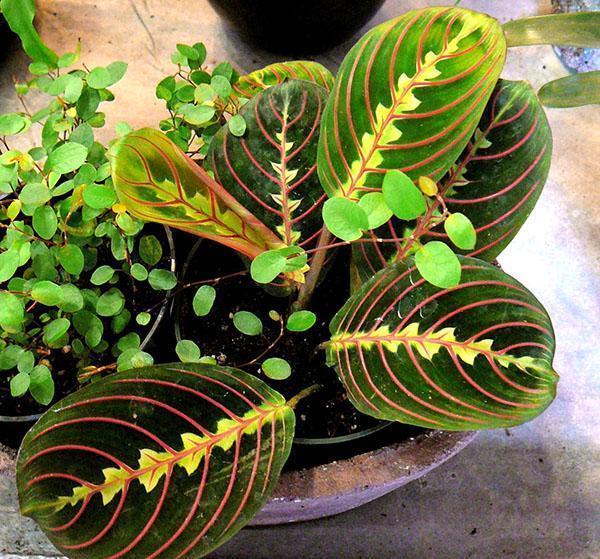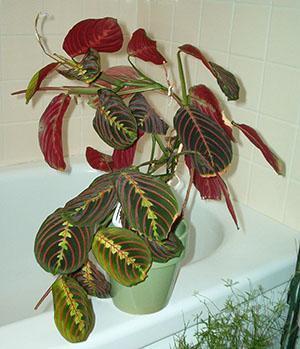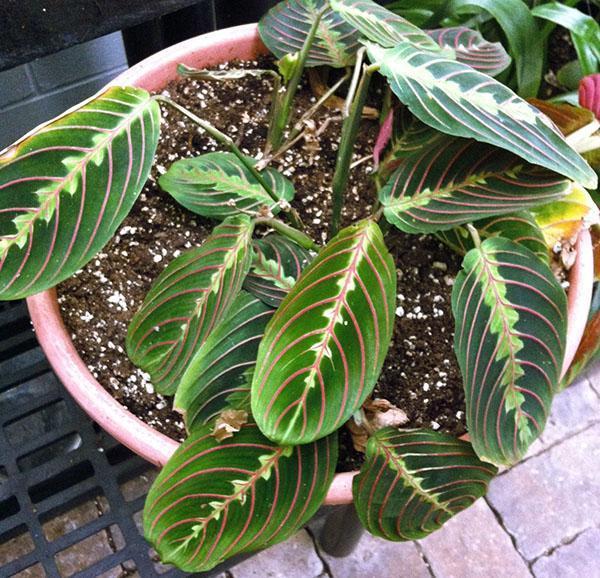Breeding rules and transplanting arrowroot at home
 The reason why numerous varieties of arrowroot have become of interest to lovers of indoor plants is obvious - it is large brightly colored foliage that adorns the room where the flower is kept throughout the year. Reproduction of arrowroot at home is carried out by vegetative methods. This allows you to quickly get young plants, and regular transplanting helps to rejuvenate adult specimens and give the culture new strength for growth. On this topic:arrowroot care at home!
The reason why numerous varieties of arrowroot have become of interest to lovers of indoor plants is obvious - it is large brightly colored foliage that adorns the room where the flower is kept throughout the year. Reproduction of arrowroot at home is carried out by vegetative methods. This allows you to quickly get young plants, and regular transplanting helps to rejuvenate adult specimens and give the culture new strength for growth. On this topic:arrowroot care at home!
Soil for transplanting arrowroot
At home, in the wooded tropical regions of the American continent, arrowroot lives in moist shady undergrowth. The soil of the southern deciduous forests is rich in humus, saturated with moisture and perfectly permeable to air. So that a tropical guest does not feel infringed in the house, they try to create conditions close to natural conditions. This fully applies to the selection of the substrate.
For transplanting arrowroot and planting young rooted plants, you can use ready-made soil for arrowroot, additionally adding crushed charcoal to it. This will structure the soil and reduce the risk of developing pathogenic flora.

- easy to pass moisture and air;
- keep looseness for a long time;
- provide a plant from the tropics with all its nutrient needs.
Features of transplanting arrowroot at home
 Arrowroot transplant is carried out on spring days. It is better to transfer specimens up to 3-4 years into a larger pot annually.
Arrowroot transplant is carried out on spring days. It is better to transfer specimens up to 3-4 years into a larger pot annually.
The root system, if there are no signs of illness or damage, should not be disturbed. But when the inspection reveals rot, dry areas or the presence of soil pests, you cannot hesitate:
- All problematic roots are removed with a clean, sharp knife.
- The sections are treated with carbon powder.
- Arrowroot is transplanted into a new disinfected substrate, having previously made a wide drainage layer at the bottom of the pot to drain excess moisture.
This will heal and spur the plant to growth, but for the first time it is better to put a pot of arrowroot in a greenhouse.
At a constant temperature and high humidity, the plant acclimatizes faster.
And how to transplant an arrowroot that has been living in an apartment for a long time? Adult plants need to be transplanted when their roots fully absorb the allotted volume of soil. On average, the procedure is carried out every 2-3 years, using a transplant for a preventive examination of the condition of the plant and obtaining seedlings for propagation of arrowroot by dividing the overgrown bush.
Reproduction of arrowroot
 The easiest and most effective way to grow a new arrowroot plant is to divide an adult bush. Each part must have its own roots and growth point. If, with this method of reproduction, arrowroots were damaged or the roots were cut, they must be sprinkled with crushed coal to avoid decay:
The easiest and most effective way to grow a new arrowroot plant is to divide an adult bush. Each part must have its own roots and growth point. If, with this method of reproduction, arrowroots were damaged or the roots were cut, they must be sprinkled with crushed coal to avoid decay:
- The seedlings are transferred to moist nutrient soil.
- The pots are placed in a greenhouse or covered with bags one at a time.This will retain moisture and help maintain a comfortable tropical crop environment.
For habituation and final rooting, arrowroot needs a temperature of at least 20-22 ° C and high humidity.
The indoor flower signals the successful acclimatization after division by the growth of new leaves and shoots.
How to propagate arrowroot when there is no large bush at hand worthy of giving life to new plants?
In this case, arrowroot propagation is carried out by cuttings obtained from long shoots. As such a planting material, a piece of a healthy stem with a knot is taken, next to which roots are subsequently formed, and a new shoot will appear from the sinus. The cut is made a couple of centimeters below the knot.
If the future arrowroot does not immediately fall into the water, it is better to play it safe and prepare a longer stalk, which is easy to cut just before rooting.
 Rooting is carried out in water. Most varieties form root tufts very quickly without additional care. But at the first signs of wilting, it is better to cover the planting material with a container with a bag or film. After the formation of roots sufficient for transplanting arrowroot, the seedlings are transferred to their own pots.
Rooting is carried out in water. Most varieties form root tufts very quickly without additional care. But at the first signs of wilting, it is better to cover the planting material with a container with a bag or film. After the formation of roots sufficient for transplanting arrowroot, the seedlings are transferred to their own pots.
Not all growers know about another method of breeding arrowroot. On the roots of certain species of this houseplant, small nodules are found during transplantation. If they are carefully separated and planted in the ground, after a while, strong shoots appear above the surface of the substrate and a full-fledged crown develops.